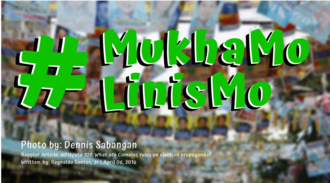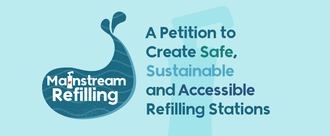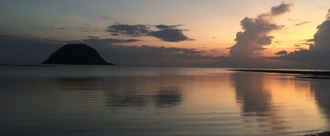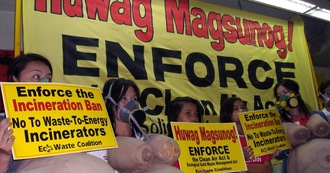-
Clean - Up Your Campaign Materials, 2019 Election Candidates & Party - lists! #MukhaMoLinisMoElection season can be one of the dirtiest season in the Philippines. Alongside with the dirty politics play and toxicity of people around, it is most especially the dirties for the environment. But this time, we won't let candidates / party-lists get away with them! 1. The campaign materials used, if not all, are mostly plastic-made. If properly disposed and collected, it will end up as waste in landfills (still not totally a good news), and if not, it will end up in other areas which will harm wildlife, marine and terrestrial ecosystems and even clog sewage systems, among others. However, there is another path for these wastes... Should there be groups or individuals that could turn these wastes into useful things, candidates and party-lists must deliver it to them. 2. Undeniably, there are much more campaign materials on public spaces than the assigned posting areas -- Public spaces such as community parks, empty houses and lots, electricity posts, (and even electric wires!) etc. Cleaning it up entails additional work load for our local communities, and a mountain top of wastes! It is not their job to clean up your wastes! 3. Every Filipino has the equal right to a pleasant, healthy, and safe surrounding and living space. And this does not include sight of candidate's face and name at every street! (With the threat of causing floods and what not..) Again, It should not be our responsibility to clean up their campaign materials! It should be theirs! In simplest words, "Mukha Mo, Linis Mo!" #MukhaMoLinisMo197 of 200 SignaturesCreated by Geane Mical
-
Save Daraitan and Tinipak River!1. The Kaliwa Watershed Forest Reserve (KWFR) is home to the indigenous Dumagat-Remontado communities, who have been stewards of their ancestral domain within the Sierra Madre since time immemorial. The Tinipak River spring is a sacred site in Barangay Daraitan, within the Dumagat-Remontado ancestral domain and declared an indigenous community conserved area. Building the 60-meter Kaliwa Dam poses the threat of inundation of portions of Barangay Daraitan and Tinipak River, as well as Infanta in Quezon. 2. Daraitan and Tinipak River provides important economic activities to local communities, from tourism, to non-timber forest products for livelihood. 3. Daraitan and Tinipak River is an ecologically important water system that enhances climate resilience. It provides key ecosystem services to downstream areas, playing an integral role in regulating water flow to the National Capital Region. Forests act as natural water filters. Globally, forested watersheds supply 75% of the world’s accessible freshwater needs. (FAO, 2016) 4. Daraitan and Tinipak River are within the Kaliwa Watershed, home to rich biodiversity and threatened wildlife, including the critically endangered Philippine Eagle. Other important species include the Endangered Northern Philippine Hawk-eagle, the Philippine Brown Deer, the Philippine Warty Pig, the Vulnerable Northern Rufous Hornbill, the Critically Endangered Philippine Eagle, and restricted-range birds of the Luzon Endemic Bird Area. The KWFR was declared a reserve by virtue of Presidential Proclamation (PP) 573 dated June 26, 1969. In April 18, 1977, PP 1636 was also issued declaring Kaliwa Watershed as a National Park and Wildlife Sanctuary. Disrupting natural ecosystems and local livelihoods by building the Kaliwa - NCWSP Dam is not the solution to water security nor sustainable development. Forests have a crucial role in building and strengthening resilience. There is a need to explore other viable alternatives. The most urgent is to protect the critical Kaliwa Watershed Forest Reserve within the Sierra Madre. Save Daraitan and Tinipak River, and the lives and species that depend on these for survival.2,231 of 3,000 SignaturesCreated by Ella Manera
-
Stop Easter Wish BALLOON Release of 'Christ, King of the Universe' Parish!GOD made us, humans, to take care of all HE has created. With this kind of event, are we taking care of our only home? Genesis 2:15 NIV The Lord God took the man and put him in the Garden of Eden to work it and take care of it. During a mass last Palm Sunday, 'Christ, King of the Universe Parish' (https://web.facebook.com/CKUParish/ ) announced that they will conduct a balloon release with wishes this Easter Sunday. All of these balloons, once released, will end up as waste in landfills and other areas which will harm wildlife, marine and terrestrial ecosystems and even clog sewage systems, among others.179 of 200 SignaturesCreated by Megumi Kawaguchi
-
Mainstream RefillingA five-year waste audit by the Global Alliance for Incinerator Alternatives (GAIA) estimates the Philippines throws away 163 million sachets everyday. 79% of “branded” plastic waste comes from food packaging, 12% from household and 8% from personal care products. Plastics can remain for 2,000 years or longer in our natural environment. If we continue business as usual, by 2050 there could be more plastic than fish in the sea by weight. Because it is produced from petroleum-based chemicals, it could account for one-fifth of the world’s total oil consumption, further accelerating global warming and deadly climate change. Government policy can be a decisive driving force for widespread transformation. The FDA Philippines safeguards public health by ensuring the safety and efficacy of food, medicine, household and cosmetics products. With the support of key government agencies such as the Environmental Management Bureau and the Department of Trade and Industry, the FDA is in a unique and powerful position to influence and transform the usage of plastic at the source through the thousands of brands it regulates. We envision that the presence of safe, appropriately regulated cosmetics and home care refilling stations that are as accessible as water refilling stations will spark a radical change in the way people and organizations consume goods and manage plastic waste. An Illinois case study showed that a single mobile water refilling station saved the equivalent of 99,000 12-ounce plastic bottles a year. In order for this transformation to take place, we raise the following three opportunities to enhance the implementing rules and regulations of Republic Act No. 9711 - The Food and Drug Administration Act of 2009: FIRST: Instead of classifying refilling activities under “filling”, a manufacturing activity under AO 2016-0003 (Guidelines on the Unified Licensing Requirements and Procedures of the FDA) and Good Manufacturing Practices, we propose that a new, separate classification be developed such as “Refilling/Repacking Stations” within a retail outlet similar to how RONPD (Retail Outlets for Non-Prescription Drugs) were developed. SECOND: To fulfill the FDA requirement of protecting consumers’ health, we propose these Refilling/Repacking Station requirements: 1. Business permit 2. Sanitary permit 3. Products (cosmetics and household) for refilling must be FDA-notified 4. Authorized refilling representative trained and certified by the company to conduct safe and sanitary refilling (patterned after food establishments’ safety compliance officer) and not necessarily a pharmacist or a graduate of an allied science profession. 5. Refilling procedures to ensure the safety of refilling 6. Flat rate fee for the refilling License to Operate similar to government agencies such as Bureau of Animal Industry (BAI) and Philippine Drug Enforcement Agency (PDEA), and not based on business capital. THIRD: If the packaging to be used is the emptied product bottle, the minimum mandatory information is already in the label. The Batch No. and Expiration Date will be stamped on the label for every refill. If the packaging to be refilled will be different from the emptied product bottle, the existing minimum mandatory requirement should be displayed on the Refilling/Repacking Stations for the consumers’ information. We propose that the following be stamped/stickered on the label for every refill: 1. Product Name 2. Batch No. 3. Expiration Date 4. Special precautions to be observed (if applicable) With this proposal, we seek to bridge the policy gaps and promote a sea change in the way responsible Filipino companies and ordinary citizens use plastics - not just temporary measures, but permanent and lasting policies, structures and systems. We hope to prepare the way for more brands to become better stewards of our earth and of human health. Join our push for safe, sustainable, widely accessible refilling stations of daily household and cosmetics products! Read the full text of the petition at bit.ly/mainstreamrefilling-pdf Signed: Anna Oposa, Co-founder & Executive Director, Save the Philippine Seas Anna Meloto-Wilk, Co-founder & President, Human Nature (Gandang Kalikasan Inc.) Sonia S. Mendoza, Chairman, Mother Earth Foundation Joel Palma, President/CEO, WWF Philippines Abigail Lois P. Aguilar, Campaigner, Greenpeace Southeast Asia-Philippines Dr. AA Yaptinchay, Executive Director, Marine Wildlife Watch of the Philippines Froilan Grate, Executive Director, GAIA Philippines/President, Mother Earth Foundation Sef Alba Carandang, Trustee & Vice President for Community Development, Philippine Reef and Rainforest Conservation Foundation, Inc. Gregg Yan, Founder & Director, Best Alternatives Campaign Angelica Mata, Founder, Zero Waste Filipina Bryan Madera, Founder, Plastic Battle Jennifer Horn, Founder, MUNI Cultural Creatives, Inc. Bryan McClelland, Founder, Bambike (Bamb Ecological Technologies, Inc.) Melissa Yeung-Yap, Founder, Got Heart Foundation, Inc. Jose Dante Albao, Executive Director, Sea Waste Education to Eradicate Plastics Binggirl Clemente, President, LAHAT Community Empowerment, Inc. Rodne Galicha, Country Manager, Climate Reality Project9,972 of 10,000 SignaturesCreated by Anna Oposa
-
Clear Seas and Skies AlbayAs the universal law of gravity states, what comes up must go down. Recently, the province of Albay has been growing into the trend of releasing sky lanterns and balloons in special events (such as the most recent one held last February 13, 2019 at Legazpi City Albay). Although the activity could look beautiful for a moment, the mess it leaves can last decades affecting us and the environment around us. Albay is home to hundreds of beautiful creatures and is also declared as a UNESCO biosphere reserve, joining a list of areas around the world that are prime examples of sustainable development and biodiversity, however with our current practices, we could lose this beautiful area to pollution. For more information on the harmful effects of the release of lanterns and balloons, check out (https://www.facebook.com/105848482838036/photos/?tab=album&album_id=1318238384932367) Help us convince our officials to ban the release of sky lanterns and balloons in Albay and save what we (and the other creatures living in Albay) call "home".81 of 100 SignaturesCreated by Titus Canete
-
STOP CEBU's La Vie in the Sky Skylanterns Release"I would like us all to make a serious commitment to respect and protect creation, to be attentive to every person, to counter the culture of waste and disposable, to promote a culture of solidarity and of encounter. Thank you." - Pope Francis. General Audience June 5th, 2013 "This same “use and throw away” logic generates so much waste, because of the disordered desire to consume more than what is really necessary." - Pope Francis (Laudato Si, 123) This activity is INTENTIONAL VIOLATION of Republic Act 9003 - mismanagement and improper segregation of waste. Likewise, of the fisheries code and wildlife act, among others. 1. What goes up must come down, and farmers in particular have become increasingly concerned that livestock might swallow a lantern's wire or bamboo frame, or, even worse, that fires might break out in hay barns. Elsewhere, coastguards say lanterns, which can travel for several kilometres and to an altitude of 1,000m before the candle burns out, are routinely mistaken for distress flares. A handful of east Asian countries, such as Vietnam, Malaysia and Thailand, have already introduced bans, particularly in the lead up to major festivals. (https://www.theguardian.com/environment/2010/feb/02/sky-lanterns-danger-farm-animals) 2. Countries like Argentina, Austria, Australia, Brazil, Chile, Colombia, Costa Rica, New Zealand, Spain, Germany, and parts of Canada and the USA have actually already banned the release of sky lanterns. (http://www.wheninmanila.com/why-we-should-not-release-balloons-skylanterns/). 3. However, the worst part of the fallout from the activity is the impact on local fauna. Reports of animals dying painfully, typically strangled by old lanterns' wires or suffocated by undecomposed paper, are frequent during this time of year. Some visitors are no doubt already aware of this, particularly following the high-profile death of an owl in the U.K. a few years ago. The bird was found suffocated and partly burnt inside the remains of a lantern... Humans are also at risk. The light emitted by lanterns sent en masse at night has been proven to be disruptive to aircraft pilots. As such, some countries like Malaysia have banned the use of sky lanterns in and around certain cities in order to prevent fatal accidents. (http://www.chinapost.com.tw/editorial/taiwan-issues/2017/02/10/491229/pingxis-sky.htm) 4. Though they are undoubtedly beautiful, even the biodegradable lanterns can be incredibly harmful to both the environment and wildlife. Sky lantern litter takes quite some time to decompose, and the wire frames have been known to strangle and maim wild animals and livestock. They also pose a significant fire hazard. Not only have they caused multiple wildfires, a sky lantern was also responsible for a massive fire at the Smethwick Recycling Plant in West Midlands, England. (http://earth911.com/living-well-being/events-entertainement/environmental-impact-traditions/) 5. With Save Philippine Seas, know more about the ills and harms of sky lantern releases here: https://www.facebook.com/pg/savephilippineseas/photos/?tab=album&album_id=13182383849323671,150 of 2,000 SignaturesCreated by Living Laudato Si' Philippines

-
STOP COVE MANILA'S BALLOON DROPIt is unsustainable, wasteful and ecologically apathetic. Cove Manila said that the balloon drop will be done indoors and will follow waste disposal guidelines but the activity in itself contradicts the basic principles of environmental sustainability. 1. All of these balloons, if not recycled, will end up as waste in landfills and other areas which will harm wildlife, marine and terrestrial ecosystems and even clog sewage systems, among others. 2. The Philippines is 3rd in the world dumping wastes into the oceans. Don't add more. 3. There are environment-friendly alternatives, read here: https://balloonsblow.org/environmentally-friendly-alternatives. Need more reference? Download Save Philippine Seas Defying Gravity Toolkit at http://www.savephilippineseas.org/toolkits Let's look reflect on the words of econetizen Grayson Gil Lidon Yañez: "Dear Cove Manila, we know this event sounds like a blast in time for the new year but we’ve never been this challenged with plastic pollution than ever before. 130,000 is a massive number of balloons and trash that could flow to the oceans in due time. We hope you reconsider your choice of material for your celebration and we would gladly help you think of more environmentally-friendly yet still fun ways to usher in the new year... We understand that it will be done indoors and that you comply with waste disposal rules. But wouldn’t it be wiser, more cost-efficient, and sustainable to prevent at source? And by this we mean completely refraining from using balloons instead. It’s 130,000 plastic/rubber balloons we are talking about here — at a single event. Chances are it will still be dumped in sites or eventually end up in the oceans. Hope you will still reconsider and help us take action in taking care of our environment. There are many ways to celebrate and have fun, but not at the expense of the environment. And again, we will gladly help you think of other ways..." Econetizen Edgar Alan Zeta-Yap adds: "Despite repeated calls by netizens this past week to find an eco-friendly alternative to their extremely wasteful event, Cove Manila of Okada Manila continues to defend their ”record-breaking” release of 130,000 balloons at their New Year’s Eve party, sponsored by Hennessy and Belvedere Vodka. Justifying that the world’s largest balloon drop will be held indoors and that proper waste disposal will be followed, they totally miss the point as the country — and the entire planet — suffers from plastic pollution on a monumental scale as it is. More than 80% of plastic waste in the country is mismanaged, and often ends up in the ocean. And the Philippines is already the world’s third largest contributor to plastic pollution in the ocean."72,226 of 130,000 SignaturesCreated by Rodne Galicha
-
Stop the field trial and impending direct use of Golden Rice!Golden Rice: A Narrow View in Addressing Malnutrition Golden Rice, a rice variety that is genetically modified to produce Vitamin A, is touted as a solution to Vitamin A deficiency (VAD) in the Philippines. However, Golden Rice will only bring more problems to health, environment and farmers rights. Here’s how: • Rice, the staple food of Filipinos, will be subjected to unsafe genetic modification • Golden Rice is a concern of everyone; if something unexpected turns out in the process of genetic engineering the consequences would be catastrophic. Golden Rice proponents will subject the Filipinos’ staple food to a technology that is not proven to be safe, more so effective. Genetic modification alters the original genetic make-up of the organism, producing new chemical products that can have negative, unintended and uncontrolled consequences. GE crops can pose harm to those who will eat it, proof of which are the numerous peer-reviewed studies stating that GE crops are unsafe to eat. • It will be nearly impossible to recall GMOs as they are capable of reproduction. GMOs contaminate our food and agriculture thru cross pollination, seed mixing or thru accidental or intentional releases. Our rice varieties, totaling to about 4,000 varieties whose genetic diversity can be tapped to combat climate stresses and alleviate nutritional problems, are at risk of contamination. • Golden Rice does not offer new solutions. Beta carotene, which Golden Rice promises to deliver, is a nutrient that exists naturally in many food crops. It is present in crops in quantities greater than Golden Rice, such as malunggay, kalabasa, saluyot, kamote, carrots and other green leafy vegetables and yellow colored fruits and root crops. While widely available, easily grown and contains more beta carotene than Golden Rice, poverty hinders the Filipino people access to these safe and nutritious foods. Add to this the absence of fats in their diets required for the absorption of Vitamin A. • VAD exists among the population, but there are existing and proven steps in curbing Vitamin A deficiency. These interventions include fortification of food and Vitamin A supplementation by the Department of Health (DOH) of the Philippines. To date, the percentage of children aged 0-5 years with VAD have already went down to about 15% in 2008, mainly from these interventions. Same goes in the case of pregnant and lactating mothers, wherein the cases of VAD also dropped within the threshold level. • Golden Rice undermines food safety, health of the environment and farmers rights • Consumer rights to information and food safety is being put at the wayside, such as the absence of labels in foods containing GMOs. The pro-Golden Rice also group ignores safety tests, and to date no tests were conducted to ascertain safety of Golden Rice. Children’s’ rights were also disregarded, as was seen in the case of the secretive and illegal Golden Rice feeding trials to young Chinese children. • There are also no studies on allergenicity and toxicity of Golden Rice, which should be first established in animal feeding trials before feeding trials on humans commence. It is shameful that the pro-GR camp will subject communities in the Philippines, which will target children, to be used as experimental rats in the feeding trials to ascertain efficacy of Golden Rice. • Questions are also being raised about Golden Rice’s role in curbing VAD. Is Golden Rice a food or a drug? If it is a drug that will cure VAD, proper dosaging of Golden Rice should be implemented and regulated, which will deem it very impractical and may pose problems such as overdosing due to overconsumption. • The pro-GR camp is using victims – the children suffering from VAD - as leverage to rush the approval of the said crop. They have also held groups against the introduction of Golden Rice responsible for the death of children suffering from VAD. These claims are baseless, as Golden Rice is still not ready for release and no proofs of its effectivity in addressing VAD were presented. IRRI, the lead proponent in the development of Golden Rice, divulged that the yield of Golden Rice is very low and would take another two years before it will be ready for cultivation. • The regulatory agencies in the country are lax and pro-GMO. To date, there is also no single law that governs GM commercialization or protection of the people from unwanted effects brought about by GM crops. • Golden Rice will ensure corporate control in agriculture • Golden Rice is a product of private corporations using the public institutions to mask their intent in controlling food and agriculture. Golden Rice is a property of Syngenta, one of the biggest Agrochemical TNC in the world. Syngenta has partnered with IRRI and created the Golden Rice Human.92 of 100 SignaturesCreated by Stop Golden Rice! Network

-
No To Petron Depot in Pongol Balogo Pasacao Camarines SurBalogo Pasacao Camarines Sur is known as one of the key player of tourism in "the summer capital of camarines sur" Pasacao, knowing that this is a tourist area putting up an oil depot that covers 2.6hctrs of land and a massive port of 800meters that could handle both inter island and international vessels would not only stop the tourism but would also Destruct the marine life, Farmers life, and the crystal clear waters of these beaches.181 of 200 SignaturesCreated by Jeth Ablaneda
-
No to Coal-fired Power Plant in La Union, the Surfing Capital of the North!La Union is under threat: the construction of a 670-megawatt coal-fired power plant (CFPP) is expected to commence this year, in the historic town of Luna, which is known for its natural geophysical and cultural assets of high ecological, livelihood and touristic value. Within the 2 to 30 aerial-kilometer radius of the proposed coal-fired plant are the towns of Balaoan, known for its bountiful corn harvests and biodiverse coral gardens; of San Juan and Bacnotan, the main surfing areas; and of San Gabriel, home to Tangadan Falls (the most popular falls in Northwest Luzon) and Lon-oy Springs (a major water supply source of the City of San Fernando and suburbs). All of these will be degraded and eventually destroyed once the CFPP starts spewing toxic chemicals. Moreover, the water heated by the plant’s cooling system will blanch and damage supersensitive corals within the Darigayos Cove, known for its rich marine ecosystem (the source of livelihood of thousands of fisherfolks) and heritage structures along its white beach. We APPEAL to President Rodrigo Duterte, DENR Secretary Roy Cimatu, DOT Secretary Bernadette Romulo-Puyat, Sen. Cynthia Villar (Environment Committee), Sen. Sherwin Gatchalian (Energy Committee), DA Secretary Manny Pinol, Congressman Pablo Ortega, Congresswoman Sandra Eriguel, Governor Francisco Emmanuel Ortega III, Vice Gov. Aureo Nisce, Mayor Victor Marron and Vice Mayor Romeo Resureccion to: 1. Deny GLEDC’s application for an environmental compliance certificate (ECC) including other permits to construct and operate the CFPP. The proponents used deceit, bribery and strong-arm tactics to suppress opposition to their plan and did not fully comply with the required ECC processes as it only consulted residents in the five (5) barangays in and around the proposed 41-hectare site and excluded/ignored other towns and barangays within the plant’s immediate impact area as shown by the NO2 modelling exercise done by its own environmental consultants. Likewise, the Environmental Impact Assessment done by GLEDC’s consultants was also found to be technically deficient and misleading by other technical experts. 2. Pursue an alternative development agenda that is consistent with the Agri-Tourism Development Strategy of the Provincial Government of La Union being espoused by no less than Governor Pacoy Ortega. The proposed site and the nearby Darigayos Cove and Mt Kangisitan can instead be developed as an ecotourism zone linked with other touristic attractions of La Union. 3. Identify and develop renewable energy sources to augment the country’s power supply. As La Union has a very high photovoltaic potential, more solar farms similar to those in Batangas should be built as soon as possible.6,703 of 7,000 SignaturesCreated by Koalisyon Isalbar ti Pintas ti La Union (Coalition to Save the Beauty of La Union)

-
STOP NATIONAL ROAD CONSTRUCTION AT MT. GUITING-GUITING NATURAL PARK (SIBUYAN ISLAND, ROMBLON)Remember that Mt. Guiting-guiting is Sibuyanon’s remaining terrestrial life-support system. If we attempt to destruct its ecological balance without proper scientific and sociological bases under the principles of sustainable development, we will all suffer the consequences. At the heart of Sibuyan Island is the Mt Guiting-Guiting Natural Park (MGGNP). It is the only remaining mountain in the Philippines with relatively intact habitats along its entire elevational gradient. Mt. Guiting-Guiting’s plant and mammal biodiversity is amongst the richest in the world (Heaney and Regalado 1998, Goodman and Ingle 1997, DENR 1997) Be it known that Bayay Sibuyanon and those who seek the stoppage and investigation of this project are not against development but shall continue to promote and adhere to the targets and indicators of Sustainable Development Goals (SDGs). Sustainable development and precautionary principles must always be considered in implementing projects in ecologically sensitive and disaster prone areas. The ‘Priority Sites for Conservation in the Philippines: Key Biodiversity Areas’ document by the Protected Areas and Wildlife Bureau (PAWB), now BMB, of the Department of Environment and Natural Resources (DENR) exposes that there are one critically endangered, four endangered, and eight vulnerable species of biodiversity in Mt. Guiting-guiting Natural Park, which includes the endangered Philippine tube-nosed fruit bat, Nyctimene rabori, and a vulnerable Sibuyan pitcher plant, Nepenthes sibuyanensis. The project is not included in the Mt. Guiting-guiting Natural Park Management Plan. Almost every year, new biological species are being discovered. In 2008, a new species of stick insect has been discovered, the Pharnacia magdiwang. In 2010, a new species of shrew has been documented, Crocidura ninoyi. Gekko coi or Leonard’s Forest Gecko, named after famous taxonomist Leonardo Co, was known in 2011. And in 2012, a new owl species has been found, Ninox hilippensis spilonota; in 2014 a pitcher plant named after a Sibuyanon slain environmentalist Armin Marin, Nepenthes armin. In the same year, a rare endemic species of a tree skink Lipinia vulcania was recorded and a new species of lizard called Pseudogekko isapa sp. The Department of Environment and Natural Resources describes Sibuyan Island having "relatively rich biodiversity": "There are approximately 700 vascular plant species, including 54 species that are endemic to the island. These include Nepenthes sibuyanensis J Nerz (Sibuyan Pitcher Plant); Heterospathe sibuyanensis Becc. (Bil-is), Pinanga sibuyanensis Becc. (Tibañgan), and Orania palindan var. sibuyanensis, a wild palm; Alpinia sibuyanensis, Phyllanthus sibuyanensis, Cyathea sibuyanensis Copel. (Tree Fern); Agamyla sibuyanensis Hilliard & BL Burtt (Sibuyan lipstick plant); Myrmephytum beccarii Elmer (Sibuyan ant plant); Begonia gitingensis Elmer (Guiting-guiting begonia). Of the 700 plant species in the Island, 180 species can only be found in the Philippine archipelago. There are numerous endemic species in Mt. Guiting-Guiting that occupy specific habitats. These are found mostly in primary forest with elevation of 100 meters or higher (Madulid, Domingo, 1997). The endemic species found in the protected area are as follows: • Sararanga philippinensis grows gregariously and form distinct clumps in Peat swamp forest along riverine/riparian forest at low altitudes. • Heterospathe sibuyanensis and Ardisia sibuyanensis located in primary forest at medium altitudes; and • Nepenthes merrillii and Alpinia sibuyanensis most of these are found in primary forest between 100 and higher elevations. A total of 130 species of birds have been recorded in Sibuyan, of which 102 are either known or presumed to be breeding residents. These are: Cinnamon Bittern-Lapay (Ixobrychus cinnamomeus), Celestial Monarch (Hyphothymis coelestis), Striated Grassbird (Megalurus palustris forbesi), Rufous –lored Kingfisher (Halcyon winchelli nesydrionetes), Pygmy Swiftlet (Collocalia troglodytes), and Philippine Hawk-Eagle (Spizaetus philippensis). Sibuyan is also home to nine (9) native non-flying terrestrial mammal species, four (4) of which are endemic rodents (Goodman and Ingle, 1993). This are: Greater Sibuyan forest mouse (Apomys sp. B), Lesser Sibuyan forest mouse (Apomys sp. C), Sibuyan striped shrew-rat (Chrotomys sp. A), and Sibuyan giant moss mouse (Tarsomys sp. A) . Out of nine fruit bat species found in the island, only one (1) species, Sibuyan Pygmy fruit bat (Haplonycteris sp. A) is endemic (Goodman & Ingle, 1993). Dugongs (Dugong dugong) have also been sighted within the municipal waters and dolphins and whales are also expected to be visiting the area. There are nine (9) recorded species of lizards and geckoes two (2) which are classified as endemic and rare. Gekko romblon, the Romblon narrow-disked Gecko, appears to be limited to Tablas and Sibuyan Island."586 of 600 SignaturesCreated by Bayay Sibuyanon Inc. Romblon, Philippines

-
Uphold the Philippine Ban on Waste IncinerationIncineration, including so-called "waste-to-energy" (WTE) incineration facilities (i.e. burning waste to produce electricity), is neither a good way to manage waste nor to produce electricity. In fact, it is proven to be the most expensive, most polluting, most energy intensive and most inefficient way to manage waste and generate electricity: 1. Incineration is a major source of cancerous dioxins and furans, which are regulated under an international treaty, the Stockholm Convention on Persistent Organic Pollutants; and 2. It is also the most expensive way to produce electricity--WTE facilities cost more to construct and operate than coal or nuclear plants. But the government--through Congress and the Department of Environment and Natural Resources (DENR)--are aggressively promoting WTE incineration thinking it will magically solve the country's waste problems. House Bill 2286 seeks to repeal the incineration ban in the Philippine Clean Air Act (RA 8749) and amend the Ecological Solid Waste Management Act (RA 9003) in order to allow the entry of WTE incineration technologies in the Philippines. And the DENR is even paving the way for waste incineration, instead of of doing their duty to protect the environment. The Clean Air Act guarantees every Filipino’s right to breathe clean air and right to a healthy environment. The ban on incineration supports this. Waste incineration aside from being a major source of cancer-causing emissions, also produces particulate matter, which is identified as a leading cause of premature deaths. The bill also undermines the country’s landmark waste law, RA 9003, which calls for an ecological approach to waste management. Incinerators, and WTE incineration facilities threaten human health, pollute our air, land and water, harm our economies, contribute significantly to global warming, and fuel an unsustainable system of consumption and wasting. They have no place in an ecological waste management system, and in today's emerging circular economy. Congress and the DENR must realize that incineration is not a feasible waste treatment option. Instead, they must work toward real solutions and adopt the Zero Waste approach to waste and resource management. This can start with the strict implementation of RA 9003 which does not only save money, but also creates jobs, improves public health and mitigates climate change.139 of 200 SignaturesCreated by No Burn Pilipinas Alliance

.png)










